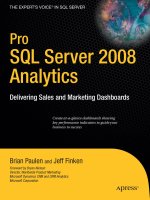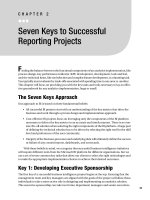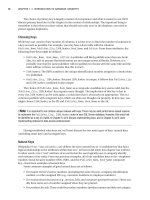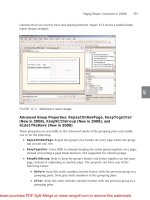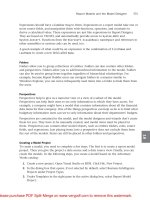Tài liệu Apress - Pro SQL Server 2008 XML (2008)02 ppt
Bạn đang xem bản rút gọn của tài liệu. Xem và tải ngay bản đầy đủ của tài liệu tại đây (405.01 KB, 20 trang )
Enter XML
W
elcome to Pro SQL Server 2008 XML. This book will cover the basics and advanced topics
of SQL Server–based XML development, including a review of legacy XML support in prior
versions of SQL Server, and a discussion of new features introduced in SQL Server 2005 and
SQL Server 2008. Throughout this book I will discuss the implementation of several advanced
XML standards via SQL Server, including XPath, XQuery, XSLT, XML Schema, and XML DML.
I will also provide coverage of other advanced XML-related topics, like SQLCLR and client-side
.NET XML capabilities and Microsoft’s .NET LINQ to XML technology.
Throughout this book, I will provide step-by-step code samples to demonstrate the con-
cepts presented. All samples are designed to run with the Microsoft AdventureWorks sample
database, unless otherwise noted. The sample code from this book is available for download
at the Apress web site (www.apress.com/download).
ADVENTUREWORKS SAMPLE DATABASE
As mentioned, the code samples in this book are designed to be run against the Microsoft AdventureWorks
sample database, unless otherwise specified in the text. Microsoft has decided to offer the SQL Server 2008
version of the AdventureWorks sample database and applications on its CodePlex web site. The URL is
www.codeplex.com/MSFTDBProdSamples. If you don’t yet have the AdventureWorks database installed
on a test server, I highly recommend that you visit CodePlex and download it. The AdventureWorks database and
business scenarios are documented on the MSDN web site at msdn2.microsoft.com/en-us/library/
ms124501.aspx.
In this chapter, I’ll provide a brief background of XML in SQL Server, a quick primer on
the World Wide Web Consortium (W3C) XML Recommendation, a comparison of XML to other
data formats, and a brief overview of XML functionality in SQL Server 2008.
Looking Back at SQL Server XML
When SQL Server 2000 was released, Microsoft was just beginning a big push to thoroughly
immerse its entire product line in XML. XML was integrated into SQL Server 2000 by adding
the FOR XML clause to the SELECT statement and adding access to various Component Object
Model (COM) components via stored procedures and functions. Some XML support was
1
CHAPTER 1
■ ■ ■
9837ch01.qxd 4/17/08 11:11 AM Page 1
provided through integration with Internet Information Services (IIS). XML data in SQL
Server 2000 was truly a second-class citizen, driving many developers to avoid using SQL Server
for all but the simplest of XML storage and retrieval tasks. The main problems with SQL
Server 2000 XML support included the following:
• Limited functionality. SQL Server 2000 XML support was provided primarily by the
FOR XML clause of the SELECT statement, the OPENXML function, and a couple of stored
procedures to create XML documents in memory and remove them when finished.
There was no built-in Transact-SQL (T-SQL) support for querying or modifying XML data.
• Complicated to use. SQL Server 2000 XML support relied on the old-style Large Object
(LOB) data types, including TEXT and NTEXT. SQL Server 2000 LOB data types were kludgy
at best.
• Inefficient implementation. SQL Server 2000 XML support also relied heavily on COM
components and external libraries, making it much less efficient than a “native” solu-
tion. Additionally, if you failed to explicitly remove a document from memory, you were
likely to cause more than a few server-side memory leaks.
SQL Server 2008 ups the ante by providing efficient native T-SQL support for XML, with
XML-centric improvements to T-SQL statements, built-in XPath, XQuery, and XML DML sup-
port, the native xml data type, XML indexes, XML views, and more. SQL Server 2008’s SQLCLR
integration can also help make XML manipulation even more flexible as you’ll see in Chapter 8.
This book is an in-depth exploration of SQL Server 2008’s powerful XML functionality.
What Is XML?
No discussion of SQL Server XML capabilities would be complete without a discussion of the
underlying technology, XML. In this section, I’ll discuss the W3C XML Recommendation.
XML is designed to be a simple, fast, and flexible text format derived from Standard
Generalized Markup Language (SGML), as defined by the ISO (International Organization for
Standardization) 8879 standard. The XML Recommendation, and its related recommendations,
are maintained by the W3C, a standards body with the mission of developing interoperable
technologies for the World Wide Web. The W3C XML 1.0 specification defines a set of rules for
adding structure and context to data through the use of markup. In addition to the XML 1.0
specification, the W3C has proposed dozens of additional XML-based specifications to stan-
dardize data transfer and sharing between applications, XML processing, querying, sharing,
and manipulation. The latest versions of the XML 1.0 and XML 1.1 Recommendations are
available at www.w3.org/TR/xml and www.w3.org/TR/xml11, respectively.
Work on the XML recommendation initially began in 1996, when it was chartered by
the W3C. Design work on XML continued through 1997, and XML 1.0 became a formal W3C
Recommendation in early 1998. Though largely defined as a subset of SGML, XML 1.0 also
adapted technology from various other sources, including the Text Encoding Initiative (TEI),
Hypertext Markup Language (HTML), and Extended Reference Concrete Syntax (ERCS), among
others. During the creation of the XML recommendation, the ISO SGML standard was updated
to maintain consistency with XML. The XML 1.1 Recommendation adds support for additional
character sets, additional encodings, and extended support for control characters in currently
supported encodings. Generally speaking, unless you have a specific need for the capabilities
of XML 1.1 (such as Unicode 2.0 or Extended Binary Coded Decimal Interchange Code [EBCDIC]
CHAPTER 1
■
ENTER XML2
9837ch01.qxd 4/17/08 11:11 AM Page 2
control character support), it is recommended that you use XML 1.0. SQL Server 2008 supports
the XML 1.0 Recommendation.
RECOMMENDATIONS VS. STANDARDS
In W3C terms, a “recommendation” is equivalent to a “standard” put forth by a sanctioned standards organi-
zation like ISO or ANSI (American National Standards Institute). Presumably the W3C chose to describe their
work in terms of recommendations instead of standards because the W3C is a voluntary organization with no
power to enforce acceptance of their standards. Individuals, organizations, and standards bodies are free to
accept or ignore W3C recommendations at will. XML and its related recommendations have, however, been
adopted as industry standards.
The XML 1.0 Recommendation was created with a very specific set of design goals in
mind. The following is a summary of these goals:
• XML should be easy to process. XML can be processed with simple custom-made
string parsers, although there are a wide variety of prebuilt parsers freely available to
facilitate XML processing.
• XML should be straightforward to use over the Internet. XML is created with plain
text, generally using one of several predefined standardized character sets (UTF-8,
UTF-16, and so on). It is designed for easy transmission through firewalls and over the
Internet using standardized Internet protocols like HTTP (Hypertext Transfer Protocol).
Binary formatted data often requires heavy manipulation for transmission using HTTP
(or other protocols) over the Internet.
• XML should be human legible. XML is, by its plain-text nature and self-documenting
structure, easy for humans to read. This makes debugging problematic XML easier than
debugging binary data files.
• XML should be easy to create. Unlike proprietary binary data formats, XML can be
easily created by anyone with a simple text editor, a more complex XML-specific editor,
or an automated process.
• XML should support a wide variety of applications. Because it is designed to be flexi-
ble and extensible, and because it inherently supports international character sets, a very
wide variety of applications can use XML.
• XML standards should be formal and concise. This design goal was created to ensure
that the XML standard was “programmer-friendly.” The idea behind this goal required
eliminating “consultant-speak” and “pretty-talk” from the standard and instead providing
formal notations and syntax that XML implementers could use to create standardized
products quickly and efficiently.
• XML should be compatible with SGML. XML was designed with cooperation of the SGML
standard committee, so XML is compatible with the SGML standard. In fact, compatibil-
ity was so important that some portions of the SGML standard were changed to ensure
compatibility during development of the XML standard.
CHAPTER 1
■
ENTER XML 3
9837ch01.qxd 4/17/08 11:11 AM Page 3
• XML should have a minimal amount of optional features, ideally zero. This design goal
was a response to SGML’s history of adding optional features in an attempt to make
SGML as general-purpose as possible. The problem is that these optional features often
made document interchange impossible. XML eliminates these types of optional fea-
tures; any XML parser should be able to read any XML document as long as it follows
the standard.
• XML should be designed and standardized quickly. This goal was adopted in order to
put a standard in place before the big software developers adopted a wide range of conflict-
ing proprietary standards to accomplish similar goals. Work began on XML in mid-1996,
with the first working draft presented later that year. XML 1.0 was adopted as a W3C Recom-
mendation in early 1998.
■
Note
I’ve presented these design goals in order of importance, as I see it anyway, for SQL Server–based
XML programmers. This order differs from the order in which they are presented in the XML Recommendation
and may not reflect others’ view of the importance of each.
To meet these goals, the designers of XML made several design decisions, including the
decision that terseness of marked up XML was not important. This directly contradicts many
other formats that strive to store their data in terse and compact formats. As a result, XML
data often has a proportionately large quantity of markup information included in it. The
nature of XML data, however, does tend to make it highly compressible by modern data com-
pression algorithms, if storage space is a high priority.
Defining XML Data
XML data is composed of several types of items:
• The Document Type Definition (DTD) is a special structure used to define entity
declarations and structure validation information (note that SQL Server XML does not
support the validation aspect).
• XML elements are containers for character data (CDATA) content in XML documents.
Each XML element is defined by matching start and end tags used to encapsulate other
XML elements and data. XML elements provide structure to XML data.
• XML attributes are closely tied to elements. Attributes provide additional context, con-
tent, and metadata to your XML markup data.
• XML comments are denoted by <!-- and --> delimiters. XML provides support for
comments to allow developers to add human-readable documentation to their XML data.
• XML processing instructions are marked by <? and ?> delimiters. A processing instruc-
tion is a means to provide additional metadata to a processing application.
• XML character references and entity character references are constructs that allow you
to insert special characters in your XML data.
CHAPTER 1
■
ENTER XML4
9837ch01.qxd 4/17/08 11:11 AM Page 4
Consider the simple XML document in Listing 1-1, which represents a simple selection of
high-grossing movies in XML format.
Listing 1-1. Sample Movies XML Document
<?xml version="1.0" encoding="UTF-16"?>
<!-- High-grossing movie listing -->
<movies>
<film>
<?style superhero?>
<name>Spider-Man</name>
<releaseDate>2002-05-03-05:00</releaseDate>
<gross area="world-wide">821706375.00</gross>
<gross area="domestic">403706375.00</gross>
<director>Sam Raimi</director>
<cast>
<actor>Maguire, Tobey</actor>
<actor>Dafoe, Willem</actor>
<actor>Dunst, Kirsten</actor>
</cast>
</film>
<film>
<?style superhero-sequel?>
<name>Spider-Man 2</name>
<releaseDate>2004-06-30-05:00</releaseDate>
<gross area="world-wide">783924485.00</gross>
<gross area="domestic">373585825.00</gross>
<director>Sam Raimi</director>
<cast>
<actor>Maguire, Tobey</actor>
<actor>Franco, James</actor>
<actor>Dunst, Kirsten</actor>
<actor>Molina, Alfred</actor>
</cast>
</film>
<film>
<?style superhero-sequel?>
<name>Spider-Man 3</name>
<releaseDate>2007-05-04-05:00</releaseDate>
<gross area=”world-wide”>888977494.00</gross>
<gross area=”domestic
”>336027292.00</gross>
<director>Sam Raimi</director>
<cast>
<actor>Maguire, Tobey</actor>
<actor>Dunst, Kirsten</actor>
<actor>Franco, James</actor>
<actor>Church, Thomas Haden</actor>
</cast>
CHAPTER 1
■
ENTER XML 5
9837ch01.qxd 4/17/08 11:11 AM Page 5
</film>
</movies>
This simple example of a well-formed XML document includes several elements, including
the root element <movies>, the <film> elements nested within it, and the subelements nested
within them. This hierarchical structure is standard fare for XML, although XML data does not
have to have a strongly regular structure as in the example. For instance, you could have <cast>
(or other) elements outside of the <film> elements if it made sense for your application.
The example also includes XML comments, which are included within the <!-- and -->
comment indicators. XML comments are nodes that are processed by XML parsers like other
XML nodes. Comment nodes are normally not used by applications during processing because
they contain human-readable comments. Finally, the example also contains processing instruc-
tions that can be used by the application during processing.
XML Requirements
The sample XML in Listing 1-1 does not include any declarations. Declarations are created via
DTDs. SQL Server supports a very small subset of DTDs, allowing you to expand entity refer-
ences in your XML data and assign default values to attributes. I will discuss DTDs further in
Chapter 3.
■
Note
SQL Server does not use DTDs to constrain the format of XML data or the content of elements and
attributes. This is a common usage of DTDs as defined by the W3C XML 1.0 Recommendation. To constrain the
content and structure of your XML, use XML schema collections instead, which are a much more powerful solution.
I also did not include character references in the example. Character references come in two
forms: character entity references and numeric character references. XML defines a small set of
predeclared character entity references so that you can include otherwise reserved characters in
your XML data. The process of converting special characters in XML to character references is
known as entitizing. XML data that contains nonentitized special characters will cause XML
parsers to reject the XML during processing. Table 1-1 lists the predeclared character entity
references supported by XML.
Table 1-1. XML Predeclared Character Entity References
Entity Description
&
The
&
entity is used when you want to include the ampersand (
&
) in your XML data.
<
The
<
entity is used when you want to include the less-than sign (
<
) in your XML data.
>
The
>
entity is used when you want to include the greater-than sign (
>
) in your XML data.
'
The
'
entity is used when you want to include the apostrophe (
'
) in your XML data.
"
The
"
entity is used when you want to include the quotation mark (
"
) in your XML data.
CHAPTER 1
■
ENTER XML6
9837ch01.qxd 4/17/08 11:11 AM Page 6
Numeric character references look similar to character entity references, but instead of
a name, they are represented by &# followed by a decimal or hexadecimal number and a semi-
colon. Numeric character references can be used to represent any valid Unicode character,
even those that already have a predeclared character entity reference. The less-than character
(<) can be represented using any of the following character references in your XML data:
<
<
<
The first character reference is the predeclared character entity reference for the less-than
sign. The second is the decimal numeric character reference for the same character. The final
example shows the hexadecimal version of the numeric character reference for that character.
Notice that the hexadecimal version has a lowercase x character between the number sign (#)
and the first hexadecimal digit of the character reference. The lowercase x indicates that the
numeric character reference is hexadecimal instead of decimal. Table 1-2 shows a small selec-
tion of common numeric character references.
Table 1-2. Sample of Common Numeric Character References
Description Symbol Code
quote "
"
ampersand &
&
less-than <
<
greater-than >
>
cent sign ¢
¢
pound symbol £
£
yen symbol ¥
¥
copyright ©
©
registered ®
®
degrees °
°
plus-minus ±
±
superscript-2
2
²
superscript-3
3
³
fraction-1/4
1
⁄
4
¼
fraction-1/2
1
⁄
2
½
fraction-3/4
3
⁄
4
¾
times ×
×
divide ÷
÷
pi π
π
ndash –
–
mdash —
—
euro symbol €
€
trademark ™
™
CHAPTER 1
■
ENTER XML 7
9837ch01.qxd 4/17/08 11:11 AM Page 7
XML VS. HTML
HTML coders will recognize similarities between XML and HTML immediately. Both are markup languages
based on subsets of the grand-daddy of markup languages, SGML. Their common ancestry means they share
similar element, attribute, and comment delimiters. In both markup languages elements define the overall
structure of the document. That’s where the similarity ends, however.
These two markup languages are designed for completely different purposes. The purpose of HTML is
to format data for display. HTML is a standard with predefined tags and attributes, is not case sensitive, and
does not preserve white space. XML, on the other hand, is designed to format and structure data. XML carries
no requirement to carry additional formatting information, and it has no predefined tags—you create your
own tags based on your XML application. XML is also case sensitive and preserves white space.
The Extensible HTML (XHTML) Recommendation is an XML application that redefines HTML in terms of
XML. Because it is based on XML, XHTML is stricter than plain HTML in terms of structure, format, and case
sensitivity; although XHTML does support less strict validation modes for backward-compatibility purposes.
Well-Formed and Valid XML
XML data comes in one of two basic forms. XML data can be represented as a fragment or it
can be a well-formed document. The SQL Server xml type can handle both forms of XML data
automatically. XML data must meet the following criteria to be considered well-formed:
1. The XML data must contain one or more elements.
2. The XML data must contain one, and only one, root element. This is the element that
contains all other elements within the XML document.
3. All elements within the XML document must be properly nested within one another.
XML structure and content can further be constrained by assigning an xml instance to an
XML schema collection. The XML schema collection contains XML schemas that are defined
per the W3C XML Schema Recommendation. XML schemas provide a flexible and powerful
tool for constraining XML data. I will detail SQL Server support for the W3C XML Schema
Recommendation in Chapter 4.
■
Note
Although the XML recommendation specifies using DTDs for simple XML document validation,
SQL Server supports only a limited subset of DTDs. SQL Server does not support DTD XML structure and
content validation.
Considering Other Formats
Although this book is about SQL Server XML functionality, I don’t want you to walk away with the
idea that XML is the only game in town. The sample data I provided in Listing 1-1 can always be
represented in a more terse and compact format (remember in XML, terseness is not considered
important). For instance, the same data represented in the common Comma Separated Values
(CSV) format used by Microsoft Excel might look like Listing 1-2.
CHAPTER 1
■
ENTER XML8
9837ch01.qxd 4/17/08 11:11 AM Page 8
